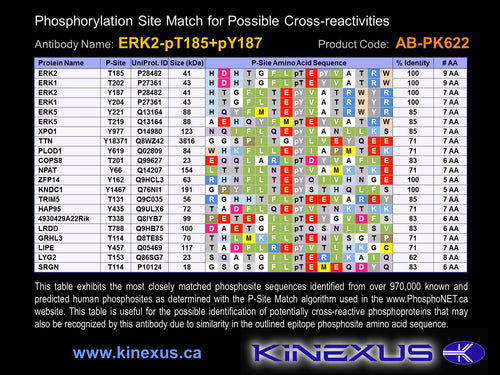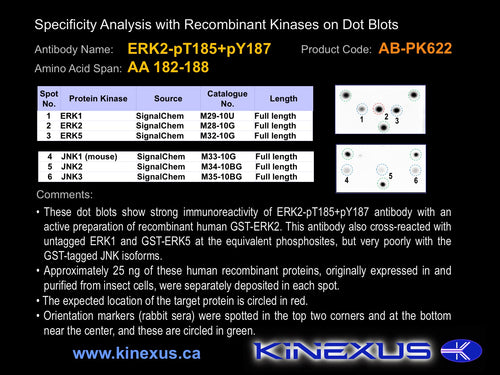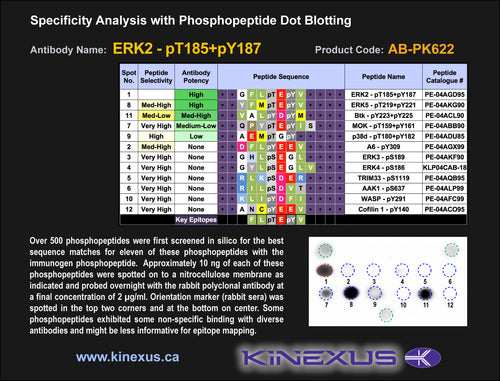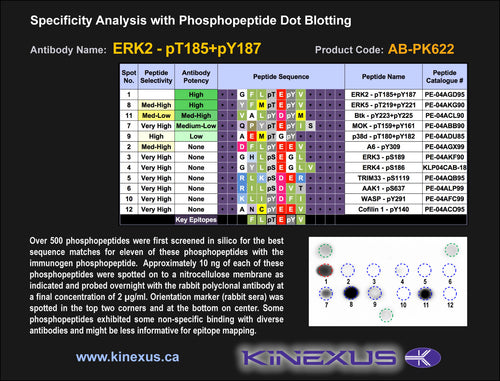Product Name:
ERK2-pT185+pY187
Product Number:
ab-pk622
Target Full Name: Extracellular regulated protein-serine kinase 2 (p42 MAP kinase)
Target Alias: ERK; ERK-2; ERT1; Extracellular signal regulated kinase 2; Kinase ERK2; MAP kinase 2; MAP kinase isoform p42; MAPK; MAPK 2; PRKM2; p41mapk; CCDS13795.1; ENSG00000100030
Product Type Specific: Protein kinase phosphosite-specific antibody
Antibody Code: PK622
Antibody Target Type: Phosphosite-specific
Antibody Phosphosite: T185+Y187
Protein UniProt: P28482
Protein SigNET: P28482
Antibody Type: Polyclonal
Antibody Host Species: Rabbit
Antibody Immunogen Source: Human ERK2 (MAPK1) sequence peptide Cat. No.: PE-04AGD95
Antibody Immunogen Sequence: GFL(pT)E(pY)V(bA)C
Antibody Immunogen Description: Corresponds to amino acid residues G182 to V188; In the protein kinase catalytic domain activation T loop region between subdomains VII and VIII.
Production Method: Corresponds to amino acid residues G182 to V188; In the protein kinase catalytic domain activation T loop region between subdomains VII and VIII.
Antibody Modification: Protein kinase phosphosite-specific antibody
Antibody Concentration: 1 mg/ml
Storage Buffer: Phosphate buffered saline pH 7.4, 0.05% Thimerasol
Storage Conditions: For long term storage, keep frozen at -40°C or lower. Stock solution can be kept at +4°C for more than 3 months. Avoid repeated freeze-thaw cycles.
Product Use: Western blotting | Antibody microarray
Antibody Dilution Recommended: 2 µg/ml for immunoblotting
Antibody Potency: Strong immunoreactivity of a target-sized protein by Western blotting in maturing sea star oocyte and A431 cells. It also detects in ERK1 and ERK2 in A549, HeLa, and MCF7 cells. Medium immunoreactivity with immunogen peptide on dot blots. Very strong immunoreactivity with recombinant human ERK2 on protein dot blots.
Antibody Species Reactivity: Human
Antibody Positive Control: The observed molecular mass of the processed target protein on SDS-PAGE gels is reported to be around 40-44 kDa.
Antibody Specificity: Very high
Antibody Cross Reactivity: Weak immunoreactivity on protein dot blots with a recombinant human ERK2 preparation and strong immunoreactivity with recombinant human ERK5. Immunoreacts with both phospho-ERK1 and phospho-ERK2. No other significant cross-reactivities were detected in maturing sea star oocytes and A431, A549, HeLa and MCF7 cells.
Related Product 1: ERK2-pT185+pY187 blocking peptide
Related Product 2: ERK2-1 pan-specific antibody (Cat. No.: AB-NK056-2)
Related Product 3: ERK2-2 pan-specific antibody (Cat. No.: AB-NK056-3)
Related Product 4: ERK2-3 pan-specific antibody (Cat. No.: AB-NK056-4)
Related Product 5: ERK1-pT202+pY204 phosphosite-specific antibody (Cat. No.: AB-PK621)
Related Product 6: ERK1-pY204 phosphosite-specific antibody (Cat. No.: AB-PK864)
Related Product 7: ERK1-pT207 phosphosite-specific antibody (Cat. No.: AB-PK865)
Related Product 8: ERKSelectideA - ERK1 (MAPK3) protein kinase substrate peptide
Related Product 9: ERKSelectideB - ERK1 (MAPK3) protein kinase substrate peptide
Related Product 10: ERKSubtide - ERK1 (MAPK3) protein kinase substrate peptide
Scientific Background: ERK2 (MAPK1) is a protein-serine/threonine kinase of the CMGC group and MAPK family. It is involved in the MAP Kinase signalling pathway. The MAP kinase pathway can mediate cell adhesion, growth, survival, differentiation, meiosis, mitosis, and other post-mitotic functions. Phosphorylation of T185 and Y187 by MEK1 an MEK2 increases its phosphotransferase activity. It phosphorylates many diffrent transcription factors, such as ELK1. It acts as transcriptional repressor by binding directly to DNA. It is essential for cyclin D1 induction. MAPK1 phosphorylates BCL2, which contributes to cell survival, the suppression of the apoptotic effect of BAD and up-regulation of the antiapoptotic protein MCL-1. It regulates accumulation of p53 during DNA damage response. ERK2 appears to be a tumour requiring protein (TRP). The active form of the protein kinase normally acts to promote tumour cell proliferation. ERK2 has been linked with the Ewing's Family of tumours, which are rare cancers that are similar to medullablastoma and cerebral primitive neuroectodermal tumours. It is constitutively active in many human tumours, primarily due to altered Ras, Raf, EGFR or other upstream oncoproteins.





